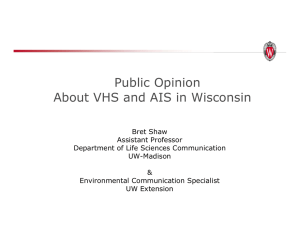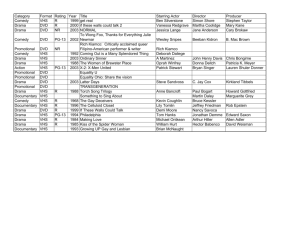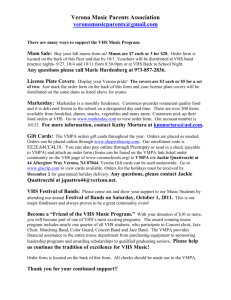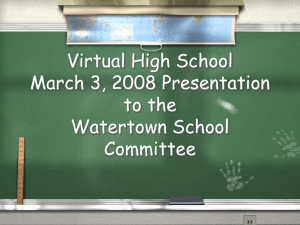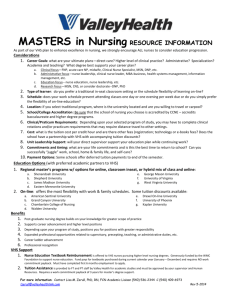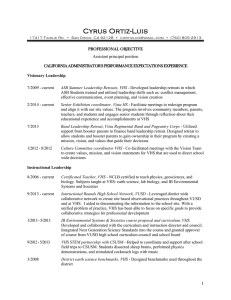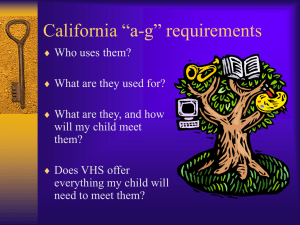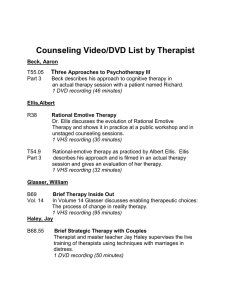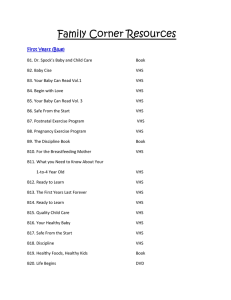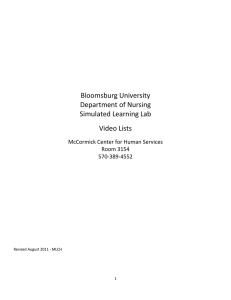About VHS - Glen Ridge Public Schools
advertisement
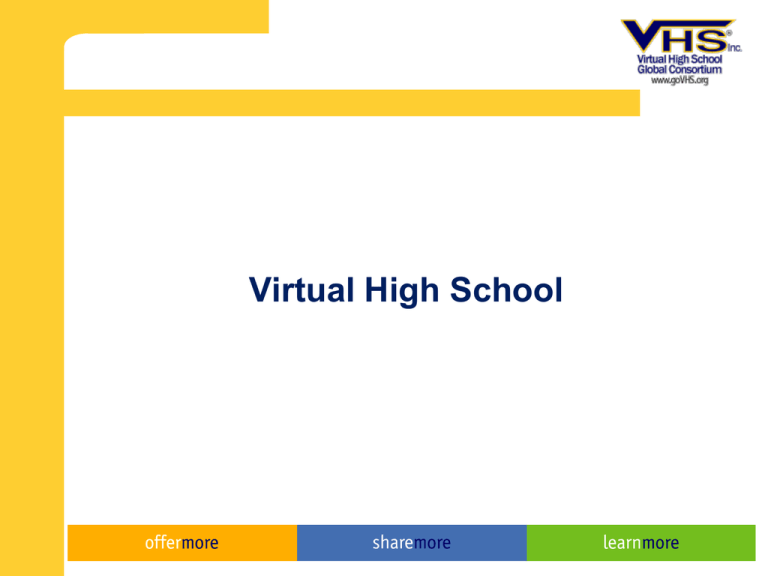
Virtual High School VHS History Founded in 1996 Concord Consortium & Hudson Public Schools, Hudson, Massachusetts $7.4M funding 1996-2001: US Dept of Education Technology Innovation Challenge Grant Purpose – – Develop Internet-based online courses for high school students Research and evaluation by SRI (Stanford Research International) Accredited by the Middle States Commission on Secondary Schools (MSCSS) VHS Mission and Beliefs Any school’s instructional process can include a high quality collaborative learning environment Education should not be limited by barriers of time, place, or lack of qualified faculty Online learning should augment (not replace) traditional teaching A collaborative network provides an abundant and generous community to share resources Benefits to Students Extensive selection of courses – – – – Classes of 25 studentparticipants from: – – – 21st Century Skills Learning with Technology AP Honors G&T Middle School – – 717 schools 33 states 43 countries 459 Teachers >13,000 students 20 Advanced Placement Courses • Art History • Biology • Calculus AB • Calculus BC • Computer Science A • Economics: Micro & Macro • English Language and Composition • English Literature and Composition • Environmental Science • European History •French Language • Government and Politics • Music Theory • Physics B • Physics C • Psychology • Spanish Language/ Spanish V • Statistics • US History • World History VHS is qualified through AP Course Audit to label their courses “AP” 38 Honors Courses 101 Ways to Write a Short Story Advanced Topics in Chemistry Algebra 2 Anatomy and Physiology Animal Behavior and Zoology Art History Arts and Ideas Astronomy Basics Bioethics Symposium Computational Science and Engineering Using Java Criminology Cultural Identity through Literature Eastern and Western Thought Environmental Chemistry Folklore and Literature of Myth, Magic and Ritual Genes and Diseases History of Photography Introduction to: – Calculus AB Chemistry – Computer Science – Economics – English Literature – Environmental Science – Government – Physics B – Psychology – Statistics – U.S. History Modern Middle East Oceanography Philosophy Preveterinary Medicine Psychology of Crime Shakespeare in Films Spanish Culture The Glory of Ancient Rome The Golden Age of Classical Greece Twentieth Century Women Authors – Select Standard Courses Academic Writing Advanced Web Design Algebra 1 American Foreign Policy American Popular Music Animation and Effects Bad Boys in Literature Basic Mandarin Biotechnology Blogs, Wikis and Web Tools Business and Personal Law Career Awareness Caribbean Art History Contemporary Irish Literature DNA Technology Entrepreneurship Epidemics Forensic Science German Language and Culture Heroes History and American Pop Music Investing in the Stock Market Journalism in the Digital Age Kindergarten Apprentice Teacher Latin 1 and 2 Literacy Skills for the 21st Century Maritime History Math You Can Use in College Meteorology Music Composition Mythology Nuclear Physics Peacemaking Personal Finance Perspectives in Health Poetry Writing Portuguese 1 Screenwriting Fundamentals Sports and American Society The Human Body The Holocaust World Religions Benefits to Schools Affordable sharing of professional resources – – Average years teaching: 16 85% hold Master’s Degree Quality Benchmarks (QBI history – 12 years) National and global community Expands scope and depth of teacher instructional skills – – Teachers: 10-Week Netcourse Instructional Methodologies Extensive delivery tools Chickering and Ehrman Seven Best Practices for Technology-Based Education* • Emphasizes time on task •High Expectations •Rich, Rapid Feedback •Active Learning •Interaction with Faculty •Interaction with Peers •Respect for diversity of learning styles and worldviews *postsecondary Why VHS? Access to hundreds of courses to fill resource gap Flexibility for scheduling – Computer Lab – Library Cost effectiveness (non-profit consortium) VHS leadership in high school distance learning Roles & Responsibilities To Ensure: • Quality of Courses • Quality of Professional Development • Quality of Services & Program • Instruction (Requires 10-week NIM course) • Communication • Regular Assessment • Course Design • New Course Development Instructor VHS Administration Site Coordinator • Recruitment • Registration • Technical Support • Represents the Instructor “on the ground” • Communication with parents, VHS, instructor •Monitor and report progress Course Delivery Asynchronous Mode Desire2Learn platform Classes follow a semester (15-wk) schedule – – Most courses semester length AP, language, and some core courses are full-year Assignments due at specified intervals Students complete work, including discussions, anytime during the week 21st Century Learning Digital-Age Literacy Includes: Basic Language Scientific Economic Technological Visual Information Multicultural Global Awareness www.ncrel.org/engauge/skills/skills.htm 21st Century Partnership – – – – – Skills for life and work in the 21st Century Founded by industry leaders, including Apple, Cisco, Dell, and Microsoft in partnership with NEA Students not prepared for demands of 21st century In addition to curriculum’s rigorous content, it must have real world relevance Employability and enterprise skills Creativity, Innovation Information literacy Flexibility, adaptability Critical thinking Collaboration Initiative, self-direction Problem solving Research, inquiry Productivity Decision making Media literacy Leadership and responsibility Communication Digital citizenship Information and communication technologies Why VHS VHS sets the standard for excellence in online education United States Distance Learning Association Awards: – – – Best Practices in Distance Learning Best Practices in Online Technology and K-12 Education Online Programming Excellence – Gold Recipient Additional VHS Awards 2001 Stockholm Challenge Award for Global Excellence in Information Technology American School Board Journal’s Magna 2000 Award for exemplary use of technology in Education Model for National Education Association online learning standards Student Success Factors Self-direction and motivation Good time management skills Good organizational skills Comfortable with technology Good reading and writing skills Inquisitive 2008 University of Tennessee Study VHS teachers surveyed to determine factors for course success – – Major factors: Time management Organization skills Frequent participation Learning style – Reading (visual) – Listening (auditory) – Seeing (visual) – Speaking (auditory) – Doing (tactile/kinesthetic) Podcasts Interactive Activities Discussion Threads & Journals Team Projects Minor factors: Technology skills Record of academic success Active Learning Student Survey Findings… Students developed independent learning skills (43 percent). – Students appreciated the quality, content, and structure of their courses (34 percent). – [I valued] the independence we are given to complete our assignments on time without a teacher physically reminding us every day. The flexible schedule is also awesome as a senior to help prepare us for college. VHS courses let me learn, the way I want and need to, and not just memorize data for standardized tests. Students valued the opportunity to interact with new people (17 percent). – You get to meet many different people from all different backgrounds which provides a very interesting learning atmosphere. …Continued Students liked the expanded access to courses (14 percent). – The online courses that are available were not part of my in-school curriculum so I decide[d] to expand my learning and prepare for college. Students felt they had quality instructors (8 percent). – My instructor gave us problems that are related to real things in life and other problems that made us think.
